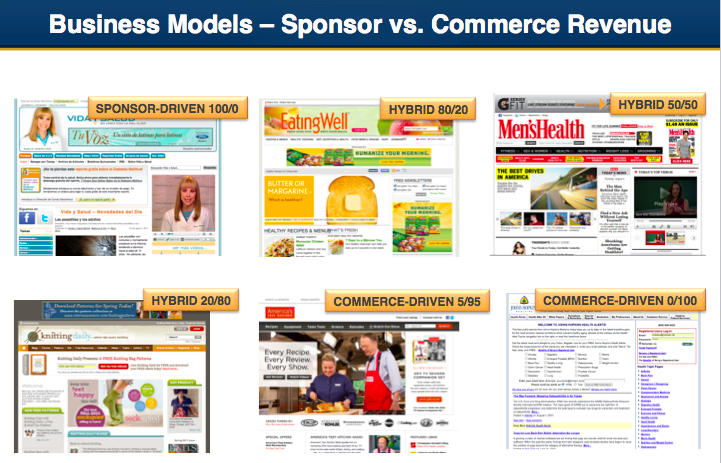All Mequoda Systems share audience development components but have different methods of generating revenue
I always find it interesting to watch, listen to and facilitate the interaction between different publishers who are new to Mequoda Summits.
One thing that often happens when talking about Mequoda Systems is that they assume it’s a single business model. Although there are thousands of publishers running systems that utilize the open content standards of a Mequoda System, those new to the system typically have a misconception that all Mequoda Systems are generating revenue the same way.
In fact, there is a continuum, from 100% sponsor-generated systems like Vida y Salud to websites like John Hopkins Health Alerts, which is 100% ecommerce-driven with the aid of books, white papers and special reports.

In the middle we have websites like Men’s Health, who operate close to a 50/50 business, where half of their revenue comes from users and the other half comes from sponsors.
Many other Mequoda Systems fall into 80/20 or 20/80 category. Dwell, for instance, generates a majority of their revenue from sponsors, but also sells products directly to consumers.
On the other hand, we have a site like Knitting Daily, who generates 80% of revenue through content-based products, directly from consumers, with approximately 20% coming from sponsors.
What do all Mequoda Systems have in common?
The answer is quite simple…
All Mequoda System publishers largely use an organic content driven system to find and bring in audiences. Once visitors come to the website of Mequoda System publishers, they are encouraged to follow and subscribe to the brand’s content through email, RSS, Twitter, Facebook and LinkedIn.
In a nutshell, all Mequoda System publishers follow the first three open content standards of being Google-Friendly, content-driven and subscriber-centric for audience development requirements.
The fourth open content standard of being multiplatform differs throughout the sites due to the company’s organizational and commerce structure.
[text_ad]
Examples of how Mequoda Systems handle monetization
Johns Hopkins Health Alerts has an extensive ecommerce store and a multi-tier checkout, which is completely absent at Vida y Salud.
Vida doesn’t have even the simplest ecommerce store because they don’t take money from audience members. Instead, Vida has very sophisticated business development, partner development and sponsor development components, which publisher Carl Kravetz spends most of his time on over anything else.
This larger ecosystem involves companies like Proctor & Gamble, Meredith and General Mills, who are all integral parts of Vida’s business model.
There is no equivalent over at Johns Hopkins as their infrastructure does not involve sponsorship deals.
Mequoda Summits lead to mutually beneficial relationships
When you put Mequoda System publishers into a room together to discuss audience development, they will talk about SEO, link building, the quality of content, the length of their free reports and the kind of person who is the right managing editor for this type of open content community.
When it comes to revenue generation discussions, they nod at each other having a general understanding, but not a deep one since they lack detailed familiarity.
All the hybrid business models, which operate both sponsorship and ecommerce models, are more complicated to run, staff and be successful with because they require two distinct organizational skill sets: world-class ecommerce and world-class partner development.
The interaction regarding business models is quite interesting as well. You’d think all sponsor-driven sites would mingle together, and vice versa, yet it’s often the opposite. Perhaps it’s because sophisticated entrepreneurs come to Summits, looking for possible moves towards a hybridized business model that falls in the middle of sponsorship and ecommerce.
This cross-pollination of ideas between publishers with different business models has resulted in very beneficial partnerships before, and is sure to happen again.
My friend Clay Hall likes to talk about a publisher’s business mix being like a three-legged stool. This approach consists of high-quality content, great audience development and business partners that appreciate their audience. Perhaps Clay should add a fourth leg, which would be store manager that caters to the audience. If a three-legged stool is stable, a four-legged one must be even sturdier.


